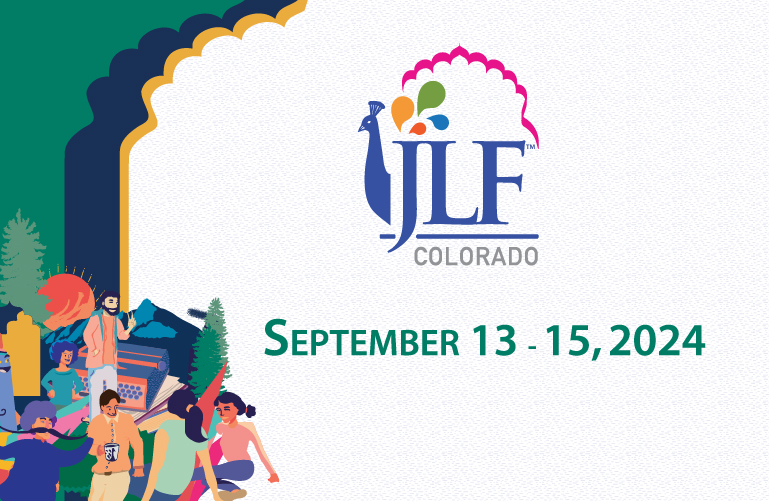


ZEE JLF at The British Library. Saturday 15 Session 11: Masala Shakespeare Jonathan Gil Harris, Rachel Dwyer, Varsha Panjwani, chaired by Cary Sawhney Paula Van Hagen, Official ZEE JLF at The British Library Blogger
Contrary to the uninformed but well intentioned fan, who congratulated author Jonathan Gil Harris for writing a book on Shakespeare and Indian cooking, the masala in Masala Shakespeare in fact celebrates not culinary-craft but a sub-genre of Hindi cinema popular in the late 1970s/80s: escapist crowdpleasers called ‘masala films’ precisely because they were committed to mixing tragedy with comedy, realism with over the top action all punctuated with unmissable song and dance routines.
Hindi cinema has in some ways always been masala – unlike many theatre traditions of the West – swerving between languages and created for a mixed viewing public. Gil Harris, currently Professor of English at Ashoka University, amusingly recounted a transformative experience in Delhi in 2001, when he watched a masala film for the first time on screen. From the perspective of the polite (and predominantly English-speaking) environment of the balcony, he watched entranced as in the pit, seats turned into accessories to be stood on and leapt over, the better to engage with the action on screen. This was a place where people from diametrically different backgrounds came together to watch films that in their plots, characterisation and even language, called out for an mixed audience and spoke of communality.
Gil Harris draws a clear line from this timestamp back to Shakespeare, who in his time wrote for a multi lingual world, where speakers used Anglo-Saxon and French influenced dialects, with a bit of legalese Latin thrown into the mix for good measure. The language of the playwright was trans-lingual in much the same way as masala film. Shakespeare has now been institutionalised as ‘Literature’ and a fixed point of standardised English, rather than the populist phenomenon he was to his contemporaries. For Gil Harris, there is no doubt that with this embracing of a mixed society, masala film interpretations of Shakespeare’s plays help to make better sense of the original work.
Varsha Panjwani, Lecturer in Shakespeare at NYU London, raised her hand as someone guilty of dancing in the aisles at masala films. To much laughter and applause, she translated the lyrics of a favourite ‘item song’ in a masala film adaptation of Othello as “light a fag from the fire of my desire, sweetheart”. This may seem a world very removed from that of Shakespeare’s play, but for Pahjwani it is a fitting expression of female desire. She often uses a masala lens in her teaching as a way to look at Shakespeare’s heroines, who may have demure public faces but have been created with fire in their belly. She is fascinated by the impact of masala film in giving life to a revealing new perspective on Shakespeare’s woman. The Bollywood tradition – for example in the role of the Mother – mixes its themes with a Shakespearean perspective, to create a multilayered depiction of a new kind of feminist icon.
Cary Sawhney, Director of BFI London Indian Film Festival, asked us to consider that while Shakespeare is a great storyteller, can we view his plays without seeing them as part of the expansion of the British Empire and colonisation through arts and culture. Shakespeare has become heavily embedded in Indian culture and is pervasive in the Indian psyche as a result of this movement.
Gil Harris agreed that while there were times Shakespeare has been viewed as a form of cultural medicine, there were other routes taken in his assimilation into Indian culture. In the 19th century a theatre in Bombay drew on excerpts from his plays, learnt by rote as a kind of ‘karaoke culture’ which could be twisted into new plays and performances, not least of which was a Hamlet with a happy ending. There was no sense of a sacredness of text, much as Shakespeare himself did with his source material: there is instead a cooking of familiar food into an exciting meal with the extra twist of new ingredients – “ masala in a cardamon nutshell”.
Rachel Dwyer, Professor of Indian Culture and Cinema, SOAS, spoke up for a the diversity of Indian films. With the demise of masala film, we are seeing the emergence of new film genres including the challenging strand of nationalistic film, alongside Tamil and south Indian film genres, which also use Shakespearean material to inspire new work.
Sawhney drew this fascinating and vibrant session to a close with an open invitation to visit the London Indian Film Festival (20-29 June 2019), which this year will have screenings in London, Halifax, Manchester and Birmingham and is a great way for each of us to test the ideas put forward by today’s panel

Leave a comment